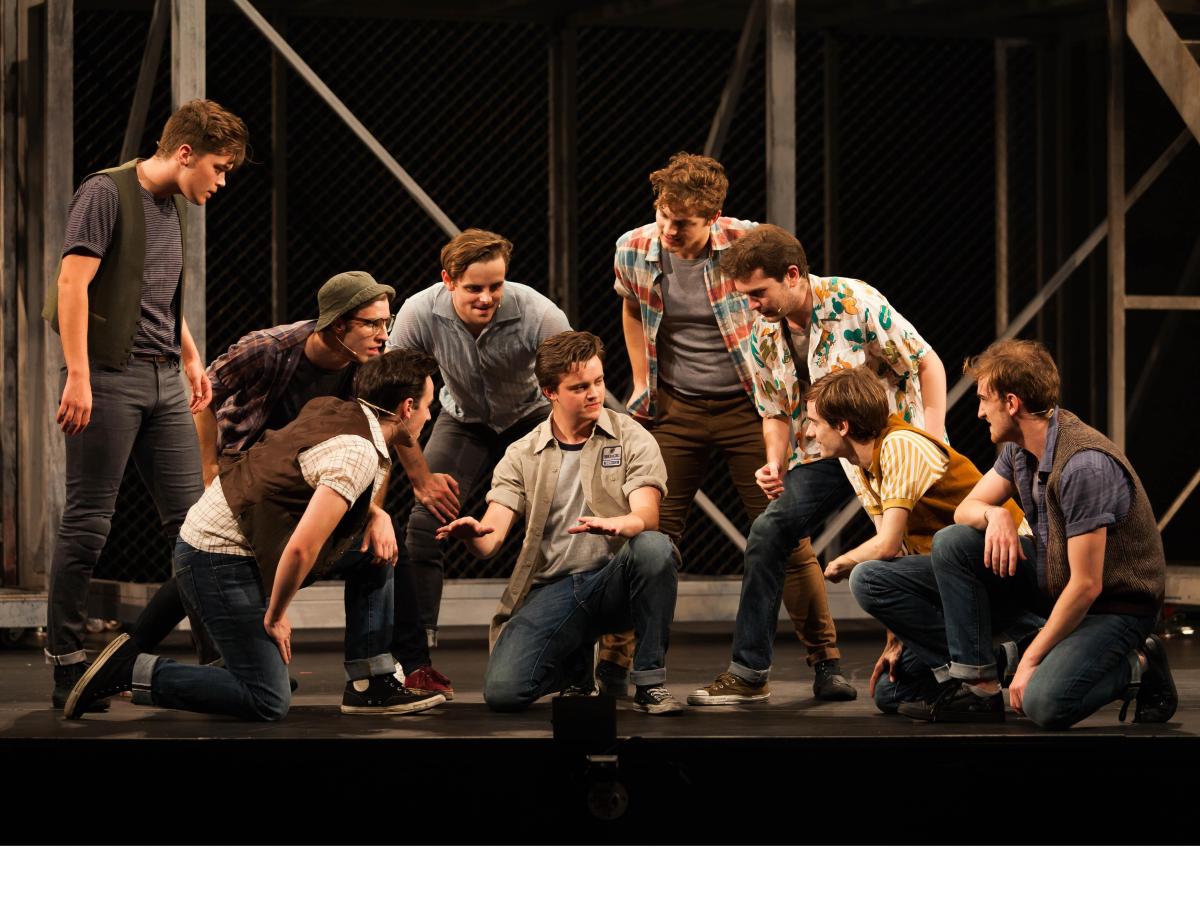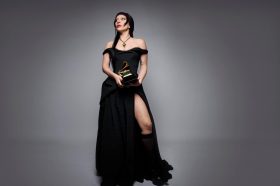Photo by Nick Morrissey.
Perhaps the most celebrated of musicals, Leonard Bernstein’s immortal West Side Story is now 60 years old. First produced on Broadway in 1957 by Jerome Robbins, it adapts Shakespeare’s Romeo and Juliet by transporting the story to New York City, where rival gangs fight out their differences on the streets. The jazz-inspired score by a young Bernstein, brilliant choreography from Robbins and a heart-felt libretto from the novice Stephen Sondheim still resonate today. Its universal truths about immigration, racial tension and the need to belong, confront us daily in news bulletins. The story is as relevant and fresh today as it was 60 years ago, and 400 years before that.
Queensland Conservatorium – Griffith University’s production of West Side Story as realised by its third year Musical Theatre students (with assistance from first and second years and all orchestral departments) is a high-quality production by a young cast whose commitment and skills are palpable. It has the advantage of a raw energy as well as a distinctive, gauche youthfulness, a quality often lacking in more professional productions. Refreshingly unpolished, it touches the heart strings in ways that more sophisticated offerings may not.
All credit should go the professional creative team engaged to bring this work to life, whose skills and knowledge elicited a production with the highest integrity and values.
Shaun Gurton’s evocative set, a series of skeletal steel structures built on moving trucks, emulates the skyscrapers and apartments buildings of New York in the ‘50s. Used for intimate scenes such as the dress shop, Maria’s bedroom and Doc’s drugstore, the structures also open up the stage for the powerful gym scene, playground and rumble under a concrete freeway. Multi-levelled, with a myriad of staircases, this set proved visually exciting while the constant changes highlighted the speed at which the action itself moves.
Nigel Levings’ impressive lighting evoked the mood swings and changes from day to night, expansive to intimate, with aplomb and he was able to recreate the tensions between combatants and joyous scenes, such as America, by the use of strong and effective colour. He brought Gurton’s stark set effectively to life at many key moments. Steve Thornely’s sound design and operation was spot-on and both dialogue and lyrics were well, but not overly, miked. Gayle MacGregor’s costumes and accessories, squarely set in the 50s, with great attention paid to wigs or haircuts, were splendid.
Director, Kris Stewart, tightly controlled the action and the drama of the work from the outset, using Gurton’s set well to stage some marvellous large, choreographed pieces, as well as the intimate scenes mostly between Tony and Maria. His sharp direction, making the story crystal-clear, demonstrated an innate understanding of this masterpiece while also assisting in bringing out contemporary relevance, without ever losing the production’s period feel. Through his masterly and clear interpretation, we understood these young people and why they behaved the way they did. He created fleshed-out characters, so that we had empathy with their situation and lives. The final heart-breaking scene was powerfully directed and wonderfully realised.
For the most part, Chris Horsey recreated Jerome Robbins’ original choreography extremely well and with great attention to detail. He was helped by an extraordinarily high standard of dancing and delivery from the students. Particular mention should be made of the boys in both gangs, the Jets and the Sharks, who have some of the best dances in the score. They were all first rate, from the opening Jet Song and Cool to the excellent choreographed fight sequences in The Rumble. Horsey also delivered tightly controlled dance sequences in the gym scene within a stage packed with students. Unfortunately, America, usually one of the exhilarating highlights of any production, missed its mark, due to what appeared to be some uninspiring dancing rather than the choreography itself. Horsey also choregraphed a contemporary ballet sequence on an open white stage during There’s a Place for Us in Act 2, which slowed the action and did not quite come off.
Musically, Bernstein’s score was delivered at the highest level by conductor, Peter Morris. The Conservatorium Symphony Orchestra played impressively from the first note of the ferocious Prologue through to the melancholic strains of the Finale with impressive commitment and amazing skill. Considered by many to be one of the finest musical scores ever written, Bernstein’s work is also extremely difficult to play. Morris managed to squeeze every drop of emotion and drama from his young players with a thoughtful reading, while creating mood and atmosphere. The intonation was excellent while his interpretation added colour and warmth, with some luscious soulful moments in the lyrical passages and strong blues and jazz beats in the dramatic scenes. The percussion, brass and saxophones, who have so much to contribute, were all first-rate.
The cast, assisted by a terrific production, strong direction and choreography, and fantastic musical support, rose strongly to the occasion and there was barely a weak link.
Tony (Grady Swithenbank) started a little shakily with some pitch problems but he soon got over that and delivered a fine understated yet exuberant performance. He has a lovely timbre to his voice and looked every part an adolescent, all-American boy. He made Tony a dreamer, in love for the first time and oblivious to anything else, and we believed him. His renditions of Maria and Tonight were both terrific. Courtney Monsma was a marvellous Maria, petite, dark haired, believable as the young immigrant; with a gorgeous voice, she matched Tony beautifully and even managed to make I Feel Pretty, a really difficult song for anyone, totally meaningful. Riff (Oliver Lacey) and Bernardo (Austin Cornish) were both excellent in their respective roles as leaders of the Jets and Sharks. They were strongly supported by their followers, the Jets making Gee, Officer Krupke a highlight of the evening. Special mention should be made of the first-rate accents, both Puerto Rican, New York and the strong Police Bronx accents.
A phenomenal achievement on every level, this was an impressive, highly proficient and finely realised production, which bodes well for the future careers of the talented musical theatre students at the Queensland Conservatorium, Griffith University.
4 ½ stars out of 5
West Side Story
Based on a concept by Jerome Robbins
Book by Arthur Laurents
Music by Leonard Bernstein
Lyrics by Stephen Sondheim
Entire original production Directed and Choreographed by Jerome Robbins
Conservatorium Theatre, QCGU, Southbank
Season concludes 5 August




